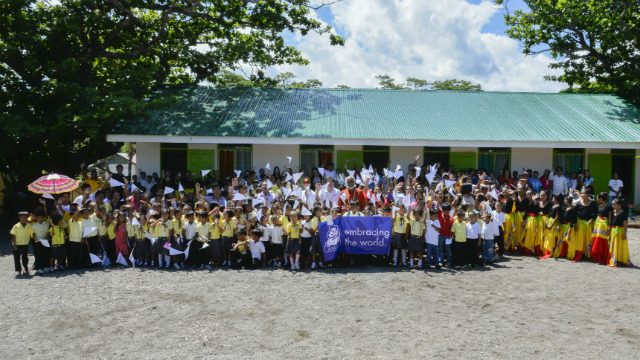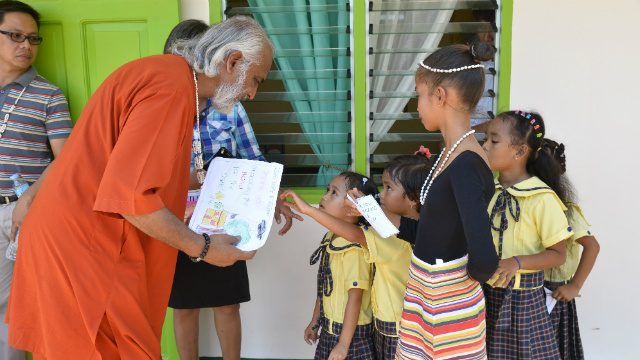SUMMARY
This is AI generated summarization, which may have errors. For context, always refer to the full article.

MANILA, Philippines – Almost two years later, rehabilitation for the survivors of Super Typhoon Yolanda (Haiyan) continues.
It has been a long and slow process, with obstacle after obstacle hindering the government from efficiently providing humanitarian aid to affected communities in the Visayas.
Still, rehabilitation efforts continue, with local and international organizations tirelessly doing what they can to help the government bring hope to the typhoon survivors.
On June 10 to 11, a global network of humanitarian organizations came to the Philippines to oversee the reopening of 6 classrooms in Pawa High School in Capiz and two classrooms in Lipata-Lamputong Integrated School in Antique, two schools that were destroyed when Yolanda hit the country. The students also received school supplies. (READ: Capiz young people bounce back after Yolanda and Antique’s seaweed farmers hope for recovery after Yolanda)
“After Typhoon Yolanda, we were told the buildings were wrecked and the kids had to study in tents, so it was rewarding to see them (classrooms) fresh and new,” Embracing the World (ETW) representative Lucy Fernandez said upon visiting Pawa High School.
“We heard how the typhoon left the school looking like a dumpsite, so it was very gratifying to see the [school] built with rooms [that are] airy and light [and] with large black boards,” Fernandez added.
ETW also reconstructed 3 classrooms with a common toilet and built a library in Manlilisid High School in Leyte.
According to Grace Katigbak, another ETW representative, the long-term plan for the projects is to enable the students to complete their studies.
“So it’s really to supplement whatever their needs may be, whether it be in terms of their books, their transportation, their uniforms,” she said.
The school reconstruction efforts are part of the rehabilitation projects ETW is currently funding after making a US $1-million donation to the Yolanda-Haiyan Multi-Donor Fund in 2014.
The money was sourced from ETW’s counterpart in the United States, Mata Amritanandamayi Center (MA Center). The donation was received by then-Presidential Assistant for Rehabilitation and Recovery Secretary Panfilo Lacson and Rene “Butch” Meily, president of the Philippine Disaster Recovery Foundation, a private sector-led disaster recovery and preparedness agency that is helping ETW implement its projects in the country.

Recovery efforts
ETW has a number of other projects aimed to improve the lives of Filipino typhoon survivors.
In Barangay Danao in Balud, Masbate, around 100 women are being taught an alternative source of livelihood through basket weaving.
ETW is also building a multi-purpose hall for Balud National High School in Masbate and a hanging bridge for Barangay Panipiason in Madalag, Aklan.
The group is working with the Corporate Network for Disaster Response as well to implement the Noah’s Ark Project in Balud, Masbate and Lawaan, Eastern Samar, where residents in several coastal barangays will be taught about flood preparedness.
After Typhoon Ruby made landfall in the country in December 2014, ETW donated about 2,000 relief packs to 10 barangays in Dolores, Eastern Samar.
“After these projects, we’ll be starting this year to give scholarships out to the elementary and high school students,” Fernandez said.
ETW was formed by the India-based humanitarian and spiritual group Mata Amritanandamayi Math (MAM).
MAM’s projects were inspired by Indian spiritual leader Sri Mata Amritanandamayi Devi, known as “Amma,” or mother, among her followers.
According to Swami Ramakrishnananda Puri, a senior disciple of Amma, everyone can contribute to what Amma and ETW are currently doing.
“When I say helping, it doesn’t mean [just] money. There are people who can’t help others with the money, but they have their talents. They can use their time or as Amma says, if someone is in distress, give a few kind words to the person,” said Ramakrishnananda. – Rappler.com
If you want to know more about the ETW’s projects, you may visit their website here.
Add a comment
How does this make you feel?
There are no comments yet. Add your comment to start the conversation.